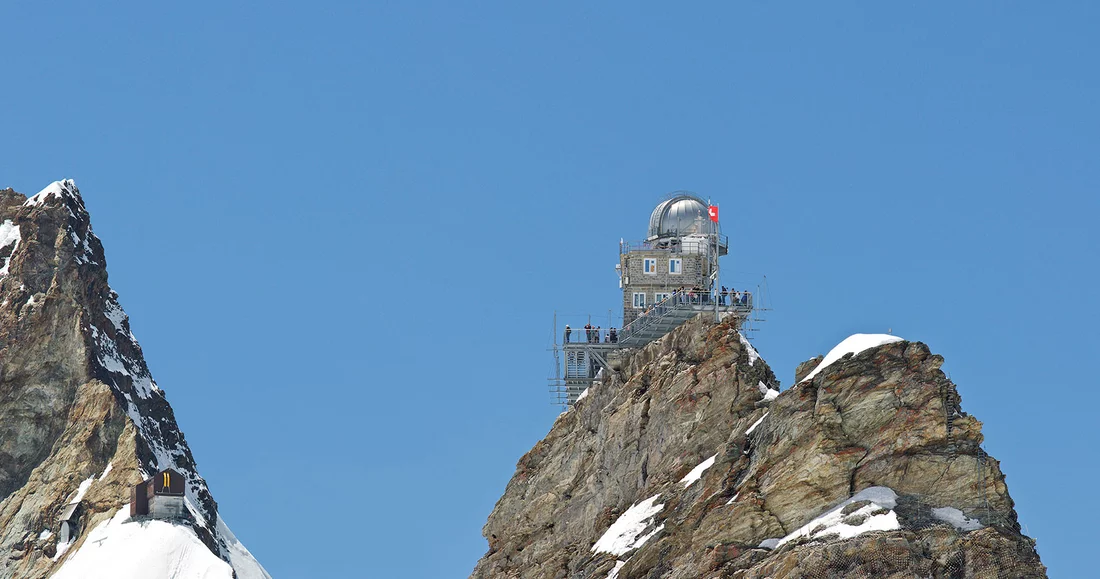For over 25 years PSI has been conducting an uninterrupted series of measurements on the Jungfraujoch, studying the impact of aerosols on our climate at 3,580 metres above sea level. The measurements are taken in the Sphinx Observatory, the landmark building on the Jungfraujoch, inaugurated in 1937. This is Europe’s highest research station that can be reached throughout the year via the legendary mountain railway, the Jungfraubahn.
Back in 1995 PSI’s Laboratory of Atmospheric Chemistry began a series of measurements that continues to this day. It has produced many new findings and every day delivers fresh raw data on aerosols. This year also sees a special field campaign in which scientists from all over the globe focus their attention on the carbon balance in the atmosphere. We chatted with Benjamin Brem, environmental engineer in the Aerosol Physics research group, to find out how such a long data series functions and what the researchers hope to achieve with the current field campaign.
The Paul Scherrer Institute conducts its measurements surrounded by the beauty of the Bernese Alps and with a stunning view over the gigantic river of ice formed by the Aletsch Glacier – where over a million tourists flock each year. Mr Brem, that must surely be a fabulous place to work?
Benjamin Brem: It certainly is a wonderful location, especially when the tourists travel back down the mountain on the last train: suddenly everything falls quiet and you feel completely cut off from the rest of the world. You’re surrounded by this unique landscape, and when the glacial ice retreats and exposes the scree beneath, you can observe first-hand the fragility of the ecosystem.
Some of the pioneering spirit of the 1930s still lives on inside the research station – the wood-panelled rooms hark back to the time when measurements were first taken, when scientists packed their kit together and headed up the mountain, where they lived and worked.
Nowadays longer stays are no longer required: we usually only visit the station once a month for calibration and maintenance work. The measuring equipment is automated and connected in real time to the server at PSI. I spend most of my working day at the computer at PSI, scrutinising data and checking their quality.
“Aerosol” has become a familiar term, chiefly as a result of the Covid pandemic. But what’s the link between aerosols and the pandemic?
Aerosol is a broad term. The scientific definition is “solid or liquid particles suspended in a gas” – tiny enough, in other words, to circulate in the air. They may be minute droplets, as in the case of Covid, carrying the virus, or also solid particles such as soot or dust from the Sahara desert. The latter two aerosols in particular affect the environment, and are thus important for our research. Although these particulates are incredibly small – in the nano- and micrometre range – high concentrations can influence the climate. Soot, for example, is black and so absorbs sunlight. This energy is released again later as heat, which warms the atmosphere. But colour can also have the opposite effect: aerosols can actually reflect the sunlight away from the Earth, allowing the atmosphere to cool. The relationship between scattering and reflection is therefore relevant for our climate and the focus of our research.
So we’re talking about microscopic particles, most of them barely visible to the naked eye. How is it even possible to measure such tiny particles?
The most common method is filter measurements, which are mainly used for fine dust, or particulates, which include aerosols. In this process the particulates are filtered out of the air and their mass or their chemical properties analysed. Our research methods, however, have steadily evolved into real-time and in-situ measurements. For example: the number of particles in a specific volume can be determined with a time resolution of less than a second. Our data even allows us to detect whether someone has been smoking near the station or if a helicopter has flown past. These outliers obviously need to be recorded appropriately in the data set.
Many particle properties are measured using optical methods, but mass spectrometry is also being increasingly used in long-term measurements to analyse the chemical composition of the particulates.
PSI has been recording the measurement series on the Jungfraujoch for the past 27 years. What’s the purpose of such a long observation period?
Our measurements are part of both a European and global research network. These networks were originally set up to monitor long-term changes in the atmosphere. Understanding such changes is extremely important for the authorities. They make it possible to determine whether certain policy decisions have a positive impact on controlling air pollution, for example.
Apart from climate models, which rely on extended data series for calibration, real-time data can also increasingly be used to predict air quality and the weather. We had an enquiry from Germany’s meteorology service, for example, about supplying them with data detailing the properties and distribution of particle sizes of Sahara dust and their relevance for solar radiation. They can incorporate this data in their models in order to predict the effect of Sahara dust on the energy production of solar power plants.
Our research is also very useful for case studies in which we investigate, for example, how the climate-relevant properties of aerosols change through transport across the atmosphere or how aerosols affect the formation and properties of clouds. Understanding these processes is important for improving climate models.
What are the advantages of the Jungfraujoch as a location for your measurements?
Due to its high altitude, the Jungfraujoch provides a very special environment – it is often located in what is known as the free troposphere. Intuitively, warm air should always rise upwards. Due to the temperature structure of the atmosphere, however, a natural barrier occurs from a certain altitude. A possible analogy is the image of low stratus clouds that always sit in the same place – here the planetary boundary layer, i.e. the lowest layer of the atmosphere directly on the surface of planet Earth, ends, and above it the free troposphere begins. This temperature-related barrier prevents the exchange between the free troposphere and the polluted air from the valley below.
During the summer months, however, the strong sunlight can heat up the ground so much that layers of air break away from the polluted planetary boundary layer and rise upwards like bubbles into the free troposphere.
This is what makes the Jungfraujoch so interesting: on one hand we are able to measure the natural European background concentration of aerosols – both in winter and at night – and on the other, we can observe exchange of aerosols between the planetary boundary layer and the free troposphere in the daytime and when temperatures are high.
You and your research group are currently busy with a new field campaign. From mid-August to mid-September international scientists are gathering on the Jungfraujoch to make use of this unique infrastructure. Can you tell us a bit more about this project?
This is a European research project called ACTRIS (Aerosol, Clouds and Trace gases Research Infrastructure). With the involvement of the Swiss research institute Empa, the University of Lille in France and the University of York in the UK, we are trying to produce as comprehensive a carbon footprint as possible for trace gases and particulates in our atmosphere. The Slovenian company “Aerosol d.o.o.” and the University of Applied Sciences and Arts Northwestern Switzerland (FHNW) are also involved, allowing them to test their measuring equipment.
Since the campaign takes place in late summer when the temperatures are relatively high, air from the planetary boundary layer rises up to the Jungfraujoch virtually every day. This gives us an insight into the transport processes and the chemical composition of young carbon aerosols from the valley below – “young” in the sense that such particles are close to their source. By contrast, if we observe the particles which were transported across the free troposphere, such as soot from a forest fire in Portugal, they have already gone through an ageing cycle after residing in the atmosphere for a long time, so their chemical structure has changed. A comparison between the young and old aerosols shows how the chemical properties of carbon aerosols modify in the atmosphere, which in turn allows conclusions to be drawn about the lifespan of these particles. Finally, we can incorporate these findings into our model and thus predict the radiation properties of aerosols more accurately.
Interview: Paul Scherrer Institute/Benjamin A. Senn
Short biography
Benjamin Brem started his career in a manual rather than an academic setting, with an apprenticeship in precision engineering. After resuming his education, he graduated with an engineering diploma in biotechnology and then went to the USA to complete a master’s in agricultural and biotechnology at the University of Illinois. His PhD was in civil and environmental engineering, including in-depth study of the optical studies of carbonaceous aerosols. As a postdoc he became project leader at the Swiss Federal Laboratories for Materials Science and Technology (Empa), which, like PSI, is part of the ETH Domain. Here he collaborated with other institutions on the development of the first global particulate matter emission standard for civil aviation. In 2019 he switched to PSI where he, along with Nora Nowak, Pascal Schneider, Levi Folghera and Martin Gysel, looks after the series of long-term aerosol measurements on the Jungfraujoch, as well as interfacing with the other two networks Global Atmosphere Watch (GAW) and Aerosol, Clouds und Trace Gases Research Infrastructure (ACTRIS).
Further information
- Last 72 hours of aerosol data from Jungfraujoch
- Research above – and about – the clouds – text from 25 July 2019
- The High Altitude Research Station Jungfraujoch
- Present-day measurements yield insights into clouds of the past – media release from 26 May 2016
- Top Science at the Top of Europe – text from 13 June 2012 (only in German)
Contact
Dr. Benjamin Tobias Brem
Laboratory of Atmospheric Chemistry
Paul Scherrer Institute, Forschungsstrasse 111, 5232 Villigen PSI, Switzerland
Telephone: +41 56 310 24 65, e-mail: benjamin.brem@psi.ch
Copyright
PSI provides image and/or video material free of charge for media coverage of the content of the above text. Use of this material for other purposes is not permitted. This also includes the transfer of the image and video material into databases as well as sale by third parties.


